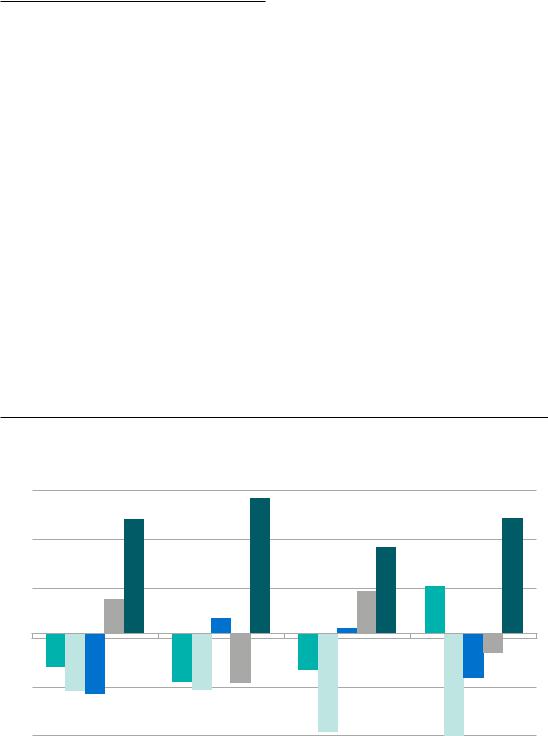
Credit Suisse - AI The-future of work_watermark
.pdf
vk.com/id446425943
Davos edition 2019
Research
Institute
AI & The Future of Work
Thought leadership from Credit Suisse Research and the world's foremost experts

vk.com/id446425943
Introduction
Big data and advances in computing power have triggered a technological revolution that have enormous bearing on the workplace and the labor market. Machines and robots are improving their capacities rapidly through artificial intelligence (AI) and innovations in design and structure. But how this digital revolution will affect firms, workers and their livelihoods is yet to be better understood.
Headline-grabbing assessments of the future of work predict polarizations and an increasing
number of individuals in good and bad jobs, while hollowing out the middle class. Trends since the
1970s confirm this specter of polarization in the USA and the UK, but so far not in continental European countries. However, while the future transformation will be profound, it may be relatively slow, leaving time for many workers
to adapt to the changes in the demand for labor.
There is an inherent difficulty for established companies to truly unleash the full potential of AI as their core strategy. It may now be time for management to think beyond the process of innovation, and also consider alternative budgeting approaches and capital structures to fuel the critical work surrounding AI.
Platforms that facilitate the exchange of goods and services are fostering an ever-growing gig economy, an employment concept in which people are paid for each specific short-term task. The most important challenge is to ensure that incomes are predictable and high enough to ensure a reasonable quality of life. However, too much regulation of freelance work could result in the curtailing or even demise of the gig economy.
While AI promises substantial advances in productivity, it should not threaten or violate human dignity. Accordingly, the legal and ethical challenges of free entrepreneurship and the need to gather vast amounts of data to develop AI are discussed in the final section of this report.
We hope that our findings will prove valuable and
I wish you a most insightful and enjoyable read.
Urs Rohner
Chairman of the Board of Directors
Credit Suisse Group AG
2

vk.com/id446425943
02 Introduction
05
What technological change means for the future of work
Rafael Lalive
Daniel Oesch
11
How to make AI transformation more likely to succeed
Howard Yu
Jialu Shan
21
Economic security in the gig economy
Giuliano Bonoli
27
AI: Legal and ethical challenges
Bettina Hummer
31 References
34
About the authors
36
General disclaimer / important information
CREDIT SUISSE AG
Research Institute Paradeplatz 8 CH-8070 Zurich Switzerland
research.institute@credit-suisse.com credit-suisse.com/researchinstitute
AI & The Future of Work |
3 |

vk.com/id446425943
4

vk.com/id446425943What technological change means for the future of work
Rafael Lalive and Daniel Oesch
University of Lausanne
Big data and advances in computing power have triggered a technological revolution that may have enormous bearing on the workplace and the labor market. Machines and robots are improving their capacities rapidly through artificial intelligence (AI) and innovations in design and structure. Digital assistants organize schedules, plan trips, and provide answers
to many questions people have. Autonomous cars drive around on our streets and can bring customers from the pick-up point to any place they desire.
These developments in technology are exciting, and bring enormous improvements, especially for consumers and entrepreneurs, but they also fuel fears that expanding artificial intelligence and machine capabilities may make humans obsolete in the production process. Our objective is to discuss how and why these fears come about, whether they were true in the recent past, and to what extent they will apply in the near future. Specifically, we first sketch a framework that allows us to discuss the effects of machines on employment. This framework is an abstraction of the real world, but is useful to assess how machines affect employment.
Second, we review how technology has affected employment in the recent past. Third, we discuss what the future of work could look like.
Analytical framework
We adopt a framework developed by Acemoglu and Autor (2011) on task allocation to discuss how technology affects employment. The framework starts with the premise that firms employ workers to fulfill tasks. A task is a unit of work that is directly needed in production. Tasks differ in terms of complexity. Workers supply effort to perform tasks and differ in terms of their skills, where “skill” refers to the capability to perform tasks. Simple tasks can be performed easily by skilled and unskilled workers, but complex tasks
can only be performed easily by skilled workers. Workers earn wages that are in line with their skills. In this context, firms will allocate tasks in a very intuitive fashion. The low-skilled workers perform the least complex tasks because their comparative advantage, the ratio of output to cost, is highest in these tasks. The high-skilled workers will perform the most complex tasks, and intermediate-skilled workers perform the skills of intermediate complexity. Workers perform the tasks that correspond to their level of skill.
Technology in the form of machines, robots or digital assistants competes with humans for tasks. Machines in factories and computers in workplaces have taken on the repetitive, but cognitively demanding work of, for instance, office clerks (automatic teller machines). Fewer workers with intermediate skills are needed to execute tasks of intermediate complexity, and these workers then compete with both lowskilled and high-skilled workers for lowand high-complexity tasks. Intermediate-level jobs will fare less well, with lower employment and lower wages. According to this line of reasoning, technology has led to a hollowing out of the middle class, a phenomenon called polarization. However, technology may also have been used to replace workers of low complexity. In this case, employment in highly-paid jobs grows
AI & The Future of Work |
5 |

vk.com/id446425943
strongest, and lower-paid jobs disappear, a phenomenon called educational upgrading. The framework identifies the primary drivers of the employment effects of technology, but only empirical analysis can tell which of the two scenarios, polarization or upgrading, is more relevant.
Machines and employment in the recent past
The view that the labor markets are polarizing has become widely accepted in economics
(Autor and Dorn 2013, Goos et al. 2014). So far, the empirical evidence for job polarization is largely limited to the USA and the UK (Wright and Dwyer 2003, Goos and Manning 2007, Autor and Dorn 2013). In contrast, most studies for Western Europe point toward the upgrading of the occupational structure (Fernandez-Macias 2012, Oesch 2013, Fernandez-Macias and Hurley 2016), which is particularly true for Switzerland (Murphy and Oesch 2018).
We assess whether polarization or upgrading is relevant for four large European economies,
Germany, Spain, Sweden and the UK. Changes in the employment structure can be empirically
analyzed by adopting the analytical strategy of job-quality quintiles (Wright and Dwyer 2003).
Its building blocks are occupations that are rankordered on the basis of their median earnings. These rank-ordered occupations are then grouped into five job-quality quintiles, with quintile 1 comprising the least-paid – and thus least-skilled – occupations and quintile 5 comprising the best-paid – and thus most advantageous – occupations. Each quintile comprised 20% of total employment at the beginning of the period under study, i.e. the early 1990s.
This allows us to calculate occupational change up to 2015 by tracing employment changes in each of the five quintiles.
Figure 1 shows the pattern of occupational change for Germany, Spain, Sweden and the
UK over the last two decades. In each one of these four European countries, employment expanded most strongly in the top quintile and either fell or stagnated in the three lowest
job-quality quintiles. The pattern of occupational upgrading is clear-cut in Germany, Sweden and Spain, whereas it has a polarizing thrust in the UK, where employment also increased in the least-paid occupations.
Figure 1: Relative change in employment across job-quality quintiles 1992–2015
In percentage points
15
10
5
0
-5
-10
|
Germany |
|
|
Spain |
|
|
Sweden |
UK |
|||
|
Quintile 1 (bottom) |
|
Q2 |
|
|
Q3 |
|
Q4 |
|
Quintile 5 (top) |
|
|
|
|
|
|
|
||||||
|
|
|
|
|
|
||||||
Data: EU-LFS (Labor Force Survey) 1992–2015 for Germany, Spain and the UK, 1997–2015 for Sweden.
Reading example: in Germany 1992–2015, the share of total employment set in the lowest-paid occupations of quintile 1 fell by 3.3 percentage points, whereas it increased by 11.7 percentage points in the highest-paid occupations of quintile 5.
Source: Oesch and Piccitto (forthcoming).
6

vk.com/id446425943
Over the last three decades, European economies have been most successful in the automation and offshoring of low-paid, low-skilled and low-status occupations such as farm workers and plant operators, data-entry clerks and sales assistants. In parallel, job expansion was most vigorous among higher-paid and better-skilled positions in management and the professions (Oesch 2013).
As a result, labor-market opportunities expanded for the salaried (upper) middle class, whereas the core of the traditional working class and subordinate white-collar employees lost ground.
For the polarization thesis to hold, we should also have observed job growth in low-skilled services among interpersonal service workers. However, this mostly female class did not substantially increase its employment share in Western Europe
(Oesch and Piccitto, forthcoming).
While the doom scenario of polarization and middle-class erosion may make newspaper headlines, it is not in line with the secular trends in Western Europe’s employment structure. Given the extent of educational expansion over the last few decades, this is good news. As technical colleges and universities were sending out highly educated workers in greater numbers, the economy was also creating more jobs in occupations requiring higher education. However, it is an altogether different question whether upgrading trends from the past translate into the future.
Disruption versus continuous change
Adopting the framework we sketched out earlier, Frey and Osborne (2017) questioned a group of machine learning experts and examined job descriptions to identify computerization bottleneck tasks that would preclude an occupation from being computerized. They estimated the share of jobs that are exposed to automation to account for 47% of total employment in the USA.
However, other scholars present very different assessments of how technology will affect the labor market of the future. Two recent OECD studies expect that 9%–14% of all jobs could be easily automated in the near future (Arntz et al. 2016, Nedelkovska and Quintini 2018). Since the OECD studies focus on individual tasks rather than entire occupations, the estimates therefore diverge widely and are very sensitive to assumptions. They point to two very distinct future scenarios: a first scenario predicts a deep break with sudden and disruptive changes, while a second scenario holds continuous and progressive change as more likely.
Automation and employment: The scenario of disruptive change
According to the scenario of disruptive change, the next wave of automation should replace employment in a wide range of activities, including agriculture, industrial production and logistics (through robotization), ground transportation (through unmanned machinery), secretarial and administrative support (through new software and Big Data), sales (through self-checkout), cleaning (through robots) and even construction (through prefabrication).
Most studies suggest that the degree of automation is negatively correlated with the level of training in a given profession. Low-skilled occupations would therefore be more exposed to technological change than occupations requiring a high level of training. More specifically for Switzerland, a recent analysis suggests that vocational education and training (VET) graduates are more threatened by automation than university graduates. While 65% of the jobs held by the former would be threatened, this is only the case for 25% of the jobs held by academics.
The disruption scenario predicts de-industrial- ization and therefore a decreasing demand for production workers employed in manufacturing.
Through its impact on the secretariat, payment management, IT maintenance and e-com- merce, digitalization would also jeopardize the jobs of commercial employees, sales assistants and retail managers. More generally, structural changes in the labor market should mainly affect the weakest areas – both in terms of educational level and geographical setting, with the peripheral regions of countries being more affected than the service centers of large cities.
Automation and employment:
The scenario of continuous change
The second scenario predicts a much more gradual change. Widespread automation will not take years, but decades in the second scenario – and will depend on various factors such as the feasibility and costs of new technological solutions as well as their legal, social and political acceptance.
The technical feasibility of automating a process does not necessarily mean that an activity will be automated and employment will disappear any time soon. Moreover, workers continuously adapt to technological change and the multiple tasks that make up an occupation will constantly evolve over time.
Some tasks appear difficult to automate, especially if they involve social skills (negotiating, coordinating, teaching or care-giving) or creative skills (inventing new products and services, creating art and culture). Therefore, automation does not seem to threaten the bulk of employment in areas such as management,
AI & The Future of Work |
7 |

vk.com/id446425943
engineering, science, education, medicine, culture or the police. New product innovation will create new tasks, and new tasks are typically given to workers who explore and develop them before they are encoded and entrusted to a machine.
New technologies will certainly lead to a decrease in jobs in some occupations and industries. Yet, at the same time, they will also generate many new jobs. By way of illustration, it can be noted that, despite strong technological progress, more than 860,000 net jobs have been created in
Switzerland over the last two decades. The
Federal Council (2017) therefore expects the adoption of digital technology, as with previous technological innovations, to contribute to job growth in Switzerland. While studies are abundant on jobs that are lost through automation, it is very difficult to estimate the number of new jobs that will be created as a result of the digital shift.
Overall, this second scenario is therefore much more optimistic. However, it does not deny that there is a need to continually adapt the population’s skills.
Which jobs in the future?
Using the second step-by-step scenario as a starting point, the employment evolution can be projected for different occupational groups using two sources. The US Bureau of Labor Statistics provides projections for employment trends between 2016 and 2026. These projections do not share the alarmism of the disruptive scenario.
On the contrary, it forecasts an increase in total employment of 7% between 2016 and 2026.
For five occupational groups, growth is expected to be much higher. The most spectacular surge is predicted for workers in health care (+24%) and personal services (+15%), particularly among home helpers, care givers and medical assistants. Two other major groups that are also expected to grow strongly are health specialists, including therapists and nurses (+15%) and computer and mathematical experts (+15%).
The largest decline is projected in the USA for production occupations (–4%), particularly among metal and mechanical engineering
workers. Employment is expected to stagnate in the agricultural trades as well as in administrative support jobs, commonly associated with the back office (0%). A third intermediate group includes occupations that are expected to grow at the same rate as the overall labor market, such as jobs in construction, catering, management and education.
A plausibility test consists of comparing these projections with the indicators that assess the current employment demand for skilled labor in
Switzerland (shortage indicators). As structural
changes in the labor market are slow, these indicators should provide us with information on the evolution of the labor market in the coming years. Shortage indicators also suggest that labor demand will remain particularly vigorous in health, where many jobs have been created over the last fifteen years (State Secretariat for Economic Affairs [SECO] 2016). It is likely that demographic aging will continue to stimulate demand for manpower in an area where the potential for automation seems limited. In
Switzerland, however, it is mainly the highly qualified professions – such as doctors or pharmacists – that are showing signs of shortage, while this is less the case for, say, dental assistants or pharmacy assistants. Switzerland also has a shortage in the so-called “MINT” professions (mathematics/information technology/natural sciences/technology) among engineers and computer scientists, as well as among specialists in management, law and education. Finally, there are no visible shortages in agriculture, the food industry, textiles, catering, commercial and administrative professions or cleaning. In
general, occupations showing the most signs of shortages have training requirements that are significantly higher than average, while the opposite is true for occupations with no shortages
(SECO 2016).
New technologies will certainly lead to a decrease in jobs in
some occupations and industries. Yet, at the same time, they will also generate many new jobs.
Technology will affect how firms recruit workers. In many markets, many workers want the same job, and many employers want the same worker.
This situation generates the problem of congested labor markets. All workers apply to the same firm, all employers invite the same candidate, and both workers and firms need to wait until the market clears. Digital platforms can use information about the preferences of workers and firms, a bit like the online dating app Tinder does
8

vk.com/id446425943
in the context of matching partners. Additional information will help speed up the matching process, especially if the market provides workers and firms with information on the feasibility of matches. More information can also lead to more inequality because information helps workers and firms pair up exactly, while currently luck is an important element of forming an employment relationship.
Conclusion
Are we heading toward a future where computers, robots and AI replace human labor and lead to mass unemployment? Warnings about a future of widespread technological unemployment are as old as the industrial revolution. They have been periodically voiced, most prominently by Jeremy Rifkin in 1992 with his book “The End of Work.” When Rifkin made his prophecy of a jobless future, the USA had a civilian labor force of 118 million people. In
2018, civilian employment increased to 155 million people – a figure that becomes truly astounding when compared to the 29 million gainfully employed workers in 1900 – among whom 40% were still employed in agriculture. Despite the huge labor-saving potential of combustion engines, assembly lines, nuclear power and micro-chips, many more people are working today in the USA than 120 years ago
– and the USA is not alone. Between 1950 and 2015, the total volume of work performed in Switzerland grew from 5.5 billion to 7.8 billion working hours (Siegenthaler 2017).
How can labor-saving technology be introduced without leading to the end of work? Computers and robots will only be used where they lead to productivity gains and, consequently, additional income. These productivity gains can benefit three groups of stakeholders: (1) the workforce whose productivity has increased in the form of wage increases; (2) business owners who benefit from an increase in their profits; or
(3) consumers who benefit from lower prices. In practice, productivity gains tend to benefit all three groups to some extent. These three groups will then use their increased income to acquire more goods and services, which should in turn lead to employment growth.
Hence our argument would be that there is no shortage of work to be done in contemporary economies. Rather, there is a lack of financial means to pay for all the work that would be socially desirable. It suffices to think of the development and maintenance of public infrastructure (public transport), healthcare (care of the elderly) or education (affordable quality pre-schools).
Rather than a jobless economy, the two great challenges in the labor market may then be massive dislocation on the one hand and the distribution of productivity gains on the other. While technological change will not lead to the end of work, it will certainly displace people from occupations and sectors. In this context, broad access to initial and further education will become increasingly important for people’s life chances. Likewise, popular support for technological progress may grow weak and weaker if the resulting productivity gains continue to be pocketed by a small elite of winners – rather than be shared widely across the workforce as was the case during the post-war decades.
Western societies benefited in the post-war decades from an institutional framework that responded well to the technological challenge created by Fordist mass production: the Keynesian class compromised with full-employment policies, strong unions and the development of the welfare state. The
democratic challenge of the next decades will be to develop a new institutional framework that allows modern societies to fully harness – and broadly share – the potential of the digital revolution.
AI & The Future of Work |
9 |

vk.com/id446425943
10
